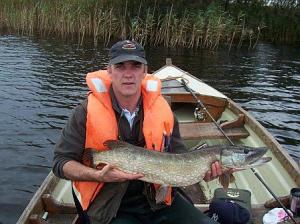Post
Cold Water Fishing Can be Dangerous
Fishing Stories, Tackle Tips & How To's theangler PM

There’s something you should be constantly aware of as you begin your spring fishing season. Fishing is much, much more dangerous now than it will be later on in the summer. The difference is cold water.
Water temperatures in most lakes will still be in the 40s – cold enough to kill some people on contact and cold enough to debilitate a warmly dressed, healthy person in an astonishingly short time.
The temperature of the water is the primary reason that a disproportionate number of drownings occur in the spring and the fall. Even though far, far fewer people are on the lakes and streams in spring and fall than in the summer, about 60 percent of all drownings occur in the so-called offseason.
The U.S. Coast Guard safety unit tells us that cold water kills people in three ways:
No. 1: People who are very out of shape or maybe have pre-existing cardiovascular problems can suffer cardiac arrest from the first shock of falling into cold water. This can happen in water as warm as the 60s.
No. 2: Even for a healthy person in good physical shape, unexpected immersion in cold water can kill outright. What happens is that he or she experiences what we call a ‘torso reflex,’ which is an open-mouthed, involuntary gasp from the shock of the cold. If a person’s face is submerged when that happens, he can take in a fatal amount of water right off the bat.
• After a plunge into cold water, the danger mounts every second a person stays there, even if he or she is a swimmer and is wearing a lifejacket.
It only takes a few minutes before a person loses strength in his fingers and can no longer grip the side of a boat or a rope. After that, even if he is a strong swimmer, a person can do little to save himself.
After 10 or 15 minutes in cold water, a person quits shivering, and fairly soon after that, the average person starts losing the ability to think clearly and make good decisions.
No. 3: Even if a person doesn’t drown, he or she can die from a drastically lowered body temperature, hypothermia. The danger remains even after a person is taken from the water and gotten into dry clothing and a warm area.
Drowning incidents involving anglers often fall into a pattern and that the victims often share certain characteristics. The characteristics of those at risk are:
Suffering from acute cabin fever after a long winter indoors.
An occupant of a small boat – typically 14 1/2 feet long.
A male in early middle age, slightly out of shape, a non-swimmer or swimmer of less-than-average ability.
A fondness for a beer or two or three while fishing.
Reluctance or refusal to wear a lifejacket.
Cabin fever is involved in a large number of accidents because sufferers are prone to go out when the water is cold.
Small boats account for by far the most drownings. Most drownings involve occupants of boats fewer than 15 feet long and powered by outboards of 10 horsepower or less.
Most drowning victims are males 25-35. Most are non-swimmers or poor swimmers.
Alcohol is involved in at least half of all drownings and maybe more.
The typical drowning accident happens something like this: two men are fishing in a small boat on a large reservoir in the spring. It is mid-afternoon and they have been out since morning. Their boat is anchored or, at least, not under power, when one of the men falls out of the boat and drowns.
Alcohol use often is involved, or suspected, because quite often there is no other explanation. Alcohol, even moderate amounts, contributes substantially to the factors that lead to drowning.
Many accidents occur in the afternoon because that’s when fatigue caused by wind, sun and the noise and vibration from boating sets in. ‘Alcohol aggravates these effects, and all these things combined can make a person lose his balance and fall out of the boat.’
Fishing this time of the year demands that anglers use extra precautions.
You just don’t go out on a lake when there is the slightest likelihood that the weather is going to pose more problems than your boat can handle. You don’t go out by yourself. Even better, you fish in a group or with at least two boats in sight all the time.
It goes without saying; you always wear your lifejacket – and not just when you’re moving. That’s a mistake many bass fishermen make. They wear their lifejackets when they are underway, then take them off when they are fishing. They don’t realize they are much more likely to be dunked when they are fishing than when they are underway.
Anglers should know what to do if they are involved in or witness an accident in which somebody is dunked in cold water.
The first thing, of course, is to get them out of the cold water as quickly as possible, without anybody else getting wet. The next thing is to get them warming as quickly as possible – into dry clothes or a blanket and into a heated car.
The person who is no longer shivering is in real danger, especially if he or she seems disoriented and uncoordinated. That person should be taken to a hospital as fast as safely possible, even if they seem recovered.
Under no circumstances, Smith should a victim of a dunking be given alcohol.
